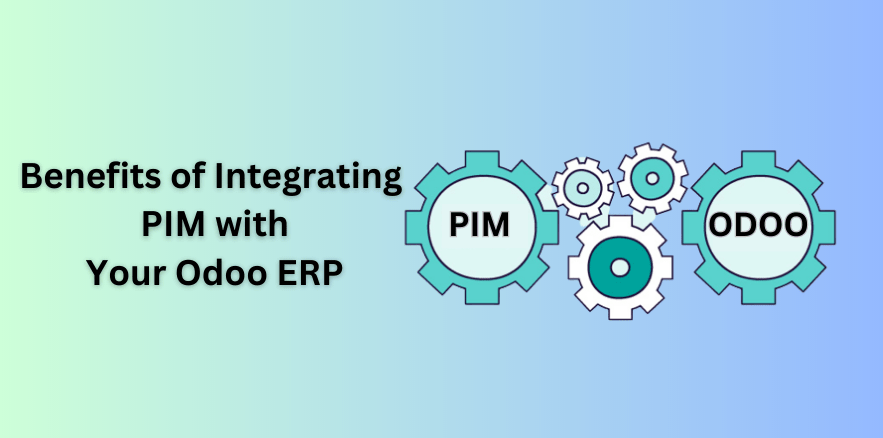Key Benefits of Integrating PIM with Your Odoo ERP
- May 15, 2023
- Posted by: tony
- Categories: Blog, ERP Implementation, Odoo

In today’s highly competitive business world, organizations must be efficient and effective to stay ahead of their competition. One way to achieve this is by integrating different business management solutions.
In this article, we will discuss the benefits of integrating a Product Information Management (PIM) solution with Odoo Enterprise Resource Planning (ERP) software.
Odoo ERP is an open-source business management software that allows you to manage various aspects of their operations, such as sales, inventory, accounting, and more, from a single platform.
On the other hand, PIM solution is software that manages and centralizes product information, including descriptions, specifications, images, and prices, in one location.
By integrating the PIM solution with Odoo ERP, businesses can significantly improve their data management, increase efficiency, reduce costs, and improve their overall customer experience.
What is a PIM Solution
A PIM solution is software that enables businesses to manage, store, and share information about their products, including descriptions, specifications, images, and prices, across multiple channels. In simple terms, it is software that centralizes all product information in one location. Product Information Management (PIM) solutions are increasingly popular among businesses that sell products online.
Functions of PIM Solution
Most businesses prefer a PIM solution because of the functional benefits it provides some of them are as follows.
Product Information Management:
One of the primary functions of a PIM solution is to manage product information. PIM solutions allow you to import and manage product data from different sources and formats, including spreadsheets, PDFs, and databases.
With PIM solutions, you can manage product information across all sales channels in real time. This means that the information is always up-to-date and consistent, regardless of the channel.
Data Quality Management:
Another function of PIM solutions is to improve product data quality. By centralizing product information, PIM solutions enable you to ensure that the product data is accurate, complete, and consistent. This leads to better decision-making, reduces errors and mistakes, and increases customer satisfaction.
Workflow Management:
PIM solutions streamline product data management processes. With PIM solutions, you can automate the process of collecting, managing, and sharing product information across different channels.
This saves time, reduces errors and manual tasks, and improves productivity. PIM solutions also allow for collaboration and approval workflows, ensuring that product information is accurate and consistent across the organization.
Channel Management:
PIM solutions enable you to manage and distribute product information across multiple channels. With PIM solutions, you can manage product information for e-commerce sites, marketplaces, print catalogs, and more. This guarantees that product information is accurate and consistent across all channels, enhancing consumer satisfaction and lowering the possibility of mistakes.
Analytics and Reporting:
PIM solutions provide you with analytics and reporting capabilities. PIM solutions allow you to track product performance and identify trends, enabling them to make informed decisions and improve your product offerings.
PIM solutions also enable you to generate reports on product data, ensuring that you have a comprehensive view of your product information.
Why do you Need a PIM Solution?
A PIM Solution can deliver a vast number of benefits to the business such as
- Improved Data Quality: By centralizing product information, a PIM solution ensures that the data is accurate, complete, and consistent across all channels. This leads to better decision-making, reduces errors and mistakes, and increases customer satisfaction.
- Enhanced Efficiency: A PIM solution automates the gathering, management, and exchange of product information, streamlining operations for product data management. Because of the time and resource savings, you may concentrate on other important activities.
- Enhanced Customer Experience: With PIM, you can improve customer satisfaction and loyalty by giving customers accurate and consistent information about their products across all channels.
- Faster Time-to-Market: With a PIM solution, you can quickly create and distribute new products across all channels, reducing the time to market for new products.
- Greater Productivity: A PIM solution reduces manual tasks associated with product data management, freeing up employees’ time to focus on more valuable activities.
- Better Collaboration: A PIM solution enables teams to collaborate more effectively, improving the accuracy and consistency of product information.
- Increased Sales: By providing accurate and rich product information, a PIM solution can help increase sales and improve customer satisfaction.
- Cost Savings: By streamlining processes, reducing errors, and improving productivity, a PIM solution can help you save costs.

What is Odoo ERP?
Odoo ERP is an open-source business management software that helps companies manage all their core business functions in one system. It provides a suite of integrated applications for managing everything from accounting, human resources, sales, inventory, manufacturing, project management, and more. Odoo ERP is highly modular, meaning you can customize it to meet their needs.
Benefits of Odoo ERP
Being an opensource ERP tool Odoo holds a lot of functional benefits that help business advancement
- Centralized Management: Odoo ERP provides a centralized platform for managing all aspects of a business. This means that you can manage all your core business functions in one system, leading to greater efficiency and productivity.
- Improved Collaboration: With Odoo ERP, teams can collaborate more effectively, sharing data and insights across departments. This leads to improved decision-making and greater collaboration between teams.
- Cost Savings: By streamlining processes and automating tasks, Odoo ERP can help you save costs and reduce waste.
- Scalability: Odoo ERP is highly modular, meaning you can customize it to meet your needs. This makes it easy for you to scale up or down as your needs change.
- Improved Data Accuracy: With Odoo ERP, you can ensure that your data is accurate and up-to-date across all departments. This results in better decision-making and improved efficiency.
- Increased Efficiency: Odoo ERP streamlines processes, automating tasks and reducing manual labor resulting in increased efficiency and productivity across the organization.
- Enhanced Customer Experience: By providing accurate and timely information to customers, Odoo ERP can help you improve the customer experience.
You can also read this blog post, “PIM with ERP : 8 signs why you need PIM with your ERP” >>
Limitations of an ERP Solution
Odoo ERP is one of the most powerful tools but they are not built for handling product information and distributing them across different channels. Let’s look into some of the limitations that the ERP tool has.
Built Differently
The reason why an ERP cannot manage rich product data at the same level as a PIM solution is due to its design. Initially, an ERP was designed to manage stock and streamline the ordering process.
The focus was on moving stock from one location to another and ensuring that the stock levels were sufficient. Therefore, the design of an ERP is transaction-based. In terms of the database model, an ERP has a relational database model with a fixed method of handling and organizing product data.
On the other hand, a PIM solution has a non-relational database model, which provides greater flexibility in accessing and restructuring product data.
Handling Digital Assets
The functionalities of ERP and PIM solutions differ significantly, particularly when it comes to managing rich media such as product images, videos, and other multimedia files.
Unlike PIM platforms that offer content delivery network (CDN) storage in the cloud for media, ERPs do not have such provisions. Consequently, PIM solutions provide more flexible access to media, allowing users to access media files from anywhere at any time.
Additionally, PIM solutions can leverage digital asset management (DAM) to store and enrich all types of digital assets. For instance, a clothing company can utilize DAM to incorporate videos into product pages. With PIM solutions, finding the relevant video within the system is relatively easy, and this feature can help to create a more interactive shopping experience for customers.
Product Relationship
When it comes to managing product relationships, PIM solutions and ERPs have significant differences. ERPs typically organize products based on how they are purchased, and they tend to have a single product hierarchy.
For instance, if a clothing store sells jeans in multiple colors, an ERP may struggle to recognize the relationships between the different colors and the product. As a result, you may have to invest significant time in manually updating the copy for each product variation.
In contrast, PIM solutions offer more flexibility when it comes to product relationships. With PIM solutions, you can efficiently organize multiple products and categories without the need to manually edit attributes such as color or material. This feature enables you to easily enrich all data instantly, streamlining the management of product relationships.
Benefits of Integrating PIM Solution with Odoo ERP
Integrating an Odoo ERP system with a PIM solution can offer numerous benefits to your business. Improved data management is one significant advantage, as it enables you to effectively manage and distribute product information across multiple channels.
Faster Time to Market
Bringing products to market can be a time-consuming and complex process that involves multiple departments and stakeholders. Tasks such as photography, copywriting, engineering, and packaging design require numerous approvals, which can lead to delays and lost revenue.
However, by integrating Odoo ERP and PIM systems, you can significantly streamline the process. This integration can help to eliminate potential barriers and enable you to launch products more quickly, ultimately improving your bottom line.
Streamlined Inventory Management
The Odoo ERP system serves as a central hub for stock information and inventory control, guaranteeing that product pages always display up-to-date stock levels. On the other hand, PIM brings together products and categorizes them based on attributes, creating a strong foundation for effective product marketing. By enabling accurate inventory information to reach multiple platforms, PIM ensures consistency across all channels.
Accurate Pricing/ Effective Marketing
The Odoo ERP system manages product pricing across different categories such as wholesale, minimum advertised, and role-based. However, it may fall short in terms of accuracy as different channels require different pricing labels.
PIM takes over the marketing and sales aspects of pricing. Once product information is received in the PIM, it generates a channel-specific sales pricing database, guaranteeing accuracy. On the other hand, the Odoo ERP system may have scattered and outdated pricing information, which is not suitable for shoppers.
By integrating the PIM with the Odd ERP, it obtains and analyzes the pricing information from the Odoo ERP, and restructures the data to provide accurate pricing details to the appropriate customers.
Accelerated data transfer
To create a successful marketing campaign, up-to-date product information is vital. Typically, you utilize item setup sheets to sort and upload product data to channels.
It requires information from both systems such as product specifications, pricing, attributes, and content including titles, descriptions, and digital assets. Integrating Odoo ERP and PIM systems accelerates data transfers and sharing of product information with retailers and distributors.
Lesser Product Returns
Accurate product dimensions play a significant role in reducing product returns, which can be costly for your business. Typically, Odoo ERP system store information on stock levels, including product dimensions and weights.
Integrating PIM with Odoo ERP allows for the automatic transfer of product dimensions and other information, preventing the need for manual data entry. With accurate product information on all customer-facing platforms, the likelihood of returns decreases, leading to lower costs and increased revenue.
Conclusion
In conclusion, the integration of Odoo ERP and PIM systems can significantly improve the efficiency and accuracy of managing product information, as well as reduce the likelihood of errors and costly returns.
By utilizing the strengths of each system, you can streamline their product management processes, from inventory control to pricing and marketing, leading to improved customer experiences and increased revenue.
With rapid data transfer, effective inventory management, and accurate product dimensions, the integration of Odoo ERP and PIM systems can help you stay ahead in a competitive market.
Schedule a conversation with us now!
Related Articles
-
Best Practices for Implementing and Managing Adobe Experience Manager
Best Practices for Implementing and Managing Adobe Experience Manager July 16, 2024 Posted by: tony Categories: Adobe Experience Manager, Blog No Comments Adobe Experience Manager (AEM) is a powerful content management platform that integrates digital asset management, site management, and content delivery to enhance customer experiences across various channels. Successful AEM implementation involves clear objectiveJuly 16, 2024 Read more -
How Does Adobe Experience Manager (AEM) Integrate with E-Commerce Platforms
How Does Adobe Experience Manager (AEM) Integrate with E-Commerce Platforms July 16, 2024 Posted by: tony Category: Uncategorized No Comments In the dynamic landscape of digital marketing, the power of Adobe Experience Manager (AEM) is amplified through its seamless integration with various systems, transforming it into a powerhouse for personalized, omnichannel customer experiences. This blogJuly 16, 2024 Read more -
Top 8 Benefits of Adobe Experience Manager for the E-Commerce Industry
Top 8 Benefits of Adobe Experience Manager for the E-Commerce Industry July 15, 2024 Posted by: tony Categories: Adobe Experience Manager, Blog No Comments Adobe Experience Manager (AEM) stands out as a premier content management solution, offering a host of benefits that elevate digital experiences. It provides seamless content management with an intuitive interface, enablesJuly 15, 2024 Read more
How can we help you?
Get in touch with a solutions consultant that can share best practices and help solve specific challenges.




